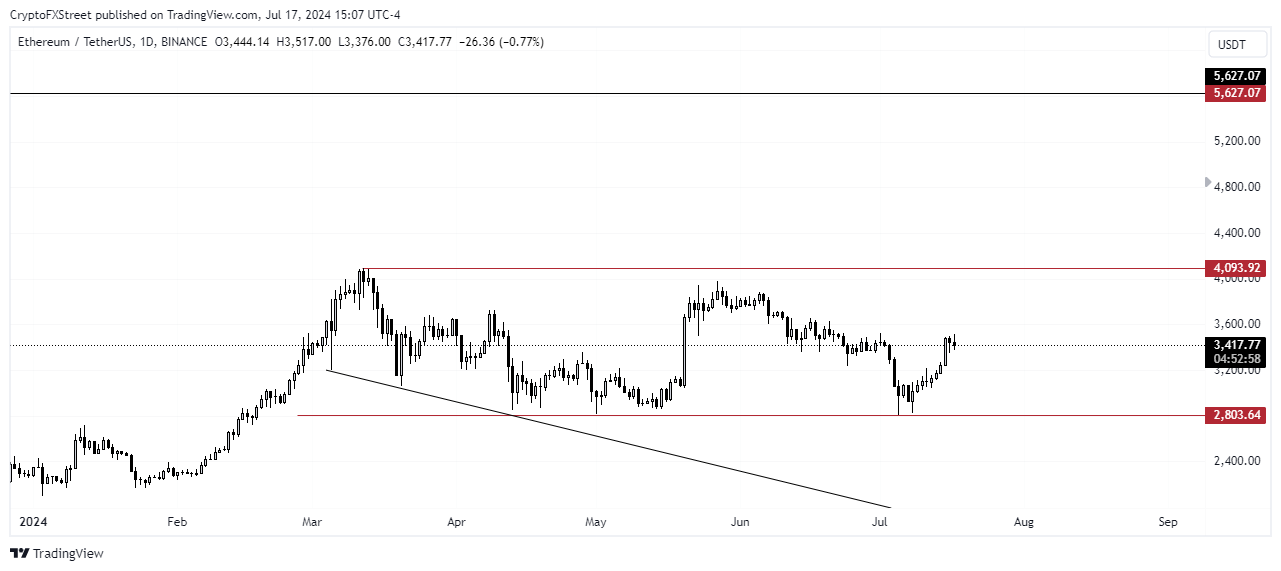Ethereum ETF issuers file final drafts in anticipation of potential Tuesday launch
- Ethereum ETF issuers have started filing their final S-1 registration statements.
- SEC Commissioner Hester Peirce believes the regulator could reconsider allowing staking in Ethereum ETFs.
- Ethereum whales could help ETH reach predicted all-time high of $5,627.
Ethereum (ETH) is down 1% on Wednesday as issuers began filing their final spot ETH ETF S-1 drafts with the Securities & Exchange Commission (SEC) in anticipation of a launch on July 23. Meanwhile, SEC commissioner Hester Peirce also said the regulator may reconsider its position on ETH staking within the ETFs.
Daily digest market movers: Issuers file final S-1s, ETH ETF staking still a possibility
Ethereum ETF issuers have begun filing their final S-1 drafts after Bloomberg analyst Eric Balchunas reported earlier that the SEC asked issuers to submit them before the end of today.
21Shares filed its updated ETH ETF draft, revealing a 0.21% fee and a six-month waiver on the first $500 million. The product will be traded under the ticker CETH.
The SEC approved spot ETH ETF 19b-4 filings of eight issuers on May 23 but needs to greenlight their S-1 registration statements before the products can go live.
The SEC could give final approval to issuers S-1s and okay them for trading on Tuesday, noted Balchunas in an X post on Monday.
Meanwhile, SEC commissioner Hester Peirce said issuers allowing staking within Ethereum ETFs could be open for reconsideration in the future.
"I think certainly something like staking, or any feature of the product (...) those are always open for reconsideration as far as I'm concerned," said Peirce. Issuers had earlier removed staking from their applications after speculations that the SEC wasn't comfortable with the concept.
ETH technical analysis: Ethereum whales could lead rally
Ethereum is trading around $3,410 on Wednesday, down nearly 1% on the day. In the past 24 hours, ETH has sustained $32.28 million worth of liquidations, with long and short liquidations accounting for $17.22 million and $14.96 million, respectively.
ETH options open interest (OI) increased slightly after a 13% rise yesterday. Open interest is the total amount of unsettled contracts in a derivatives market. ETH's continued rising options OI, combined with its recent price increase, indicates potential for more upside in the market.
Also, IntoTheBlock noticed buying pressure from wallets holding at least 0.1% of ETH's supply after its price bounced from lows seen in the past week. This indicates whales are increasing their holdings in hopes of a rally if ETH ETF launches on Tuesday.
With ETH ETF issuers filing their final S-1 drafts, popular trader Peter Brandt's earlier prediction of ETH potentially reaching a new all-time high of $5,627 is gaining more strength.

ETH/USDT 1-day chart
Brandt predicted that if ETH can complete a move to the upside of a four-month rectangle — with upper and lower boundaries at $4,093 and $2,800 — it could set a new all-time high at $5,627.
On the downside, ETH could find support around $3,235, where investors purchased over 4.54 million ETH.
Ethereum FAQs
Ethereum is a decentralized open-source blockchain with smart contracts functionality. Serving as the basal network for the Ether (ETH) cryptocurrency, it is the second largest crypto and largest altcoin by market capitalization. The Ethereum network is tailored for scalability, programmability, security, and decentralization, attributes that make it popular among developers.
Ethereum uses decentralized blockchain technology, where developers can build and deploy applications that are independent of the central authority. To make this easier, the network has a programming language in place, which helps users create self-executing smart contracts. A smart contract is basically a code that can be verified and allows inter-user transactions.
Staking is a process where investors grow their portfolios by locking their assets for a specified duration instead of selling them. It is used by most blockchains, especially the ones that employ Proof-of-Stake (PoS) mechanism, with users earning rewards as an incentive for committing their tokens. For most long-term cryptocurrency holders, staking is a strategy to make passive income from your assets, putting them to work in exchange for reward generation.
Ethereum transitioned from a Proof-of-Work (PoW) to a Proof-of-Stake (PoS) mechanism in an event christened “The Merge.” The transformation came as the network wanted to achieve more security, cut down on energy consumption by 99.95%, and execute new scaling solutions with a possible threshold of 100,000 transactions per second. With PoS, there are less entry barriers for miners considering the reduced energy demands.

